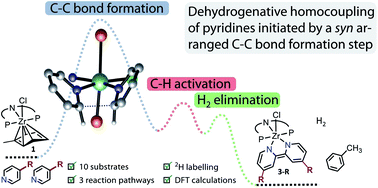当前位置:
X-MOL 学术
›
Chem. Sci.
›
论文详情
Our official English website, www.x-mol.net, welcomes your
feedback! (Note: you will need to create a separate account there.)
Dehydrogenative coupling of 4-substituted pyridines mediated by a zirconium(ii) synthon: reaction pathways and dead ends†
Chemical Science ( IF 7.6 ) Pub Date : 2018-05-16 00:00:00 , DOI: 10.1039/c8sc01025k Lukas S. Merz 1, 2, 3, 4 , Hubert Wadepohl 1, 2, 3, 4 , Eric Clot 5, 6, 7, 8, 9 , Lutz H. Gade 1, 2, 3, 4
Chemical Science ( IF 7.6 ) Pub Date : 2018-05-16 00:00:00 , DOI: 10.1039/c8sc01025k Lukas S. Merz 1, 2, 3, 4 , Hubert Wadepohl 1, 2, 3, 4 , Eric Clot 5, 6, 7, 8, 9 , Lutz H. Gade 1, 2, 3, 4
Affiliation

|
The mechanism of the reductive homocoupling of pyridine derivatives mediated by the ZrII synthon [(PNP)Zr(η6-toluene)Cl] (1) has been investigated. Selective transformation into three different types of product complexes has been observed, depending on the N-heterocyclic substrate employed: the bipyridyl complexes 3-R (R = Me, Et, tBu, Bn, Ph, CHCHPh), which are the homocoupling products, the η2-((4-dimethylamino)pyridyl) complex 4 as well as the bis(isoquinolinyl) complex 5. By deuterium labelling experiments the participation of the ligand backbone in the pyridine coupling reaction via potential cyclometallation steps was ruled out. Based on DFT modelling of the possible reaction sequences a reaction mechanism for the coupling sequence could be identified. The latter is initiated by a reductive syn C–C coupling rather than based on an initial C–H activation of the pyridine substrate.
中文翻译:

的4-取代的由锆介导的吡啶脱氢偶联(II)的合成子:反应途径和死角†
由锆介导的吡啶衍生物的还原性自偶联的机制II合成子[(PNP)的Zr(η 6 -甲苯)CL](1)进行了研究。已经观察到选择性转化为三种不同类型的产物配合物,具体取决于所用的N杂环底物:联吡啶配合物3-R(R = Me,Et,t Bu,Bn,Ph,CHCHPh),它们是均偶联产物时,η 2 - ((4-二甲基氨基)吡啶基)配合物4以及双(异喹啉基)配合物5。通过氘标记实验,配体主链通过以下途径参与吡啶偶联反应排除了潜在的环金属化步骤。基于可能反应序列的DFT建模,可以确定偶联序列的反应机理。后者是通过还原性顺式C–C偶联而不是基于吡啶底物的初始C–H活化而引发的。
更新日期:2018-05-16
中文翻译:

的4-取代的由锆介导的吡啶脱氢偶联(II)的合成子:反应途径和死角†
由锆介导的吡啶衍生物的还原性自偶联的机制II合成子[(PNP)的Zr(η 6 -甲苯)CL](1)进行了研究。已经观察到选择性转化为三种不同类型的产物配合物,具体取决于所用的N杂环底物:联吡啶配合物3-R(R = Me,Et,t Bu,Bn,Ph,CHCHPh),它们是均偶联产物时,η 2 - ((4-二甲基氨基)吡啶基)配合物4以及双(异喹啉基)配合物5。通过氘标记实验,配体主链通过以下途径参与吡啶偶联反应排除了潜在的环金属化步骤。基于可能反应序列的DFT建模,可以确定偶联序列的反应机理。后者是通过还原性顺式C–C偶联而不是基于吡啶底物的初始C–H活化而引发的。











































 京公网安备 11010802027423号
京公网安备 11010802027423号